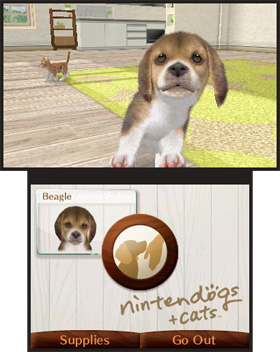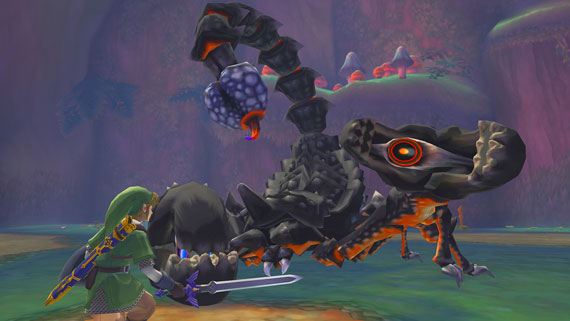
As with previous years at E3, Nintendo again invited a select few to join them in one of the Convention Center’s Theater rooms for a developers’ roundtable event, the climax of a day beginning with their press conference and ending with Shigeru Miyamoto and company speaking with press in a smaller setting for an hour and a half.
Somehow we managed to get on the list this year, and it was hard not to feel like tagging along with an elite club, especially because of the strict rule that no recording devices were allowed.
Miyamoto brought out members of Nintendo’s own elite club – The Legend of Zelda: Skyward Sword’s producer Eiji Aonuma, and Nintendo 3DS hardware producer Hideki Konno.
The talk that followed focused primarily on Zelda: Skyward Sword, the 3DS, and 3DS games – namely Nintendogs + Cats, Steel Diver, and Starfox, with most of the time restrained to those topics.

From the start of the project, both Nintendo President Satoru Iwata and Miyamoto stressed the importance of having only one person as the producer for the overall 3DS project – a role given to Hideki Konno, whose portable resume includes producing Nintendogs and Mario Kart DS, and whose full resume includes most of Nintendo’s biggest titles from the eighties onward. Konno mentioned being nervous about the initial shift from working on software to hardware, but said he eventually embraced the new role and valued the gained experience.

Miyamoto started off asking how many people had played the 3DS during the first day of E3, too which most of the room raised their hands. After a day full of surprises, Nintendo managed one more when we were suddenly presented with the revelation of Ocarina of Time on the 3DS, not simply ported, but remade for the handheld.
Miyamoto said that the motivation for this was in offering a game that allowed player’s to feel as if they were truly moving through Hyrule. He also mentioned that it had been twelve years since the original release, and that anyone who had played the game for the first time in the 6th grade would now be 24.
Amidst the laughter of him asking if anyone had played it for the first time in the 6th grade, I was one of the few who raised their hand.

Steel Diver for the 3DS was another title on the show floor, and the development for the game seems to be going well. Miyamoto joked and said this was because development has been going on for six years of course.
For those who don’t remember, the original Nintendo DS was shown at E3 six years ago, and Steel Diver was included as part of the tech demo because the slow submarine was accommodating to the touch screen. Nintendo decided that it was a perfect title to finally push forward and bring to the Nintendo 3DS.
Among the 3DS titles discussed, Star Fox grabbed plenty of attention as well. With Star Fox being the type of shooting game it is, it’s difficult to tell the spatial relationship between the ship and objects in space, but with the 3DS, there’s reason to believe that gamers will be able to maneuver the ship better with the aid of 3D visuals.

For instance, in fully rendered Mario games, players often find that floating question marks can be difficult to hit since it’s confusing to figure out exactly where it’s floating above your head.
With 3D visuals, the goal is to make those tasks—and games in general—easier to play.
A positive point for developers is they can focus on creating their games on a single spec for the 3DS and not have to worry about various hardware variables such as different brands of 3D glasses and televisions.
Admittedly I would love to play this on the 3DS, Star Fox 64 was one of my favorite games growing up and the familiarity of the controls, coupled with new 3D visuals leave me expecting a great nostalgia trip and an overdue return for the series.
When Nintendogs +Cats came up, Miyamoto had a very quotable explanation for the idea of interacting with cats. He said, “Cats are interesting, they’re kind of like girls… If they come and talk to you it’s great, but when you go and try to talk to them it doesn’t always go so well! Also, although they’re pets they do their own thing, you can’t teach them any tricks.”

It was interesting to hear about experimenting with the idea of having cats in a pet game, of putting cat models in place of the dogs in the Nintendogs program – how strange it was to tell the cat to sit, and stranger still when their tails would start wagging at the player. From there, they decided that putting cats on the screen along with dogs would be a better way to include them. Miyamoto seemed quite fascinated with how dogs and cats react to each other.
The inner camera of the 3DS will be used in the game for facial recognition to create realistic interaction between player and pet. For example, if you look at the screen and tilt your head side to side, the pet will imitate your movement; if you move your face closer to the screen, the dog will come up and lick you – additionally the pet will even recognize your face. If you hand your 3DS to a friend, the pet may have a different reaction than it would with you.
The 3DS allows for three levels of interaction with your pets – touching with the touch screen, talking with the microphone, and now visually with the camera.

Miyamoto addressed his difficulty playing Skyward Sword during the press conference with a bit of laughter, reiterating that what happened on stage was wireless interference – he had trouble shooting the spiders, and wanted the crowd to make sure their wireless devices were off.
With the Wii MotionPlus technology available, Skyward Sword was created with a heavy focus on motion enhanced gameplay during its development. The ease of swinging the sword and the ability to change items instantaneously with the Wii MotionPlus is the type of mechanism that he has wanted in the Zelda series for a long time.
One apparent improvement over earlier Zelda games is the map, which is easier to follow. Not getting lost plays into Nintendo’s goal of maintaining the core of the series while also attempting to create a more engaging experience for the player. Judging from the gameplay demo happening during the roundtable, the controls did seem very natural with the Wii MotionPlus, and it doesn’t hurt that I’m digging the slightly Impressionistic art style.

Last year at around this same time, the gameplay structure for Skyward Sword was said to be almost complete, but graphically they were able to show only a single piece of art. This year Nintendo says that they don’t want to rush for a 2010 release, taking time to polish the title and add more dungeons and bosses, pushing the title into 2011.
I respect any developer that takes the time to finalize their projects before prematurely announcing a release date, and it’s hard not to be swayed by the confidence earned by the Zelda team over the years.
The story for Skyward Sword involves Link being born and raised on a floating island called Skyloft. One day, an incident reveals another land beneath the clouds, one naturally ruled by evil forces. Due to this incident, Link is forced to visit the evil land and it becomes necessary to travel between there and Skyloft. Link is led to the evil land by the Skyward Sword. The symbolism of “sky” is said to be important in this game, as with the scene of Link falling off a cliff in the trailer.
And that was the bulk of what Nintendo had to share at their E3 2010 roundtable… except for a brief mention of that Pikmin title for the Wii – yes they are still working on that new Pikmin!
Thanks for the info Aileen. This is a great year to own a Wii and DSi. The Wii lineup is up there with the titles launched during the first 12 months of the console. Now all that is needed is a large sum of money (a bag of gold coins can be accepted as well) to purchase all of the games.
Comment by EdEN — June 21, 2010 @ 12:32 pm